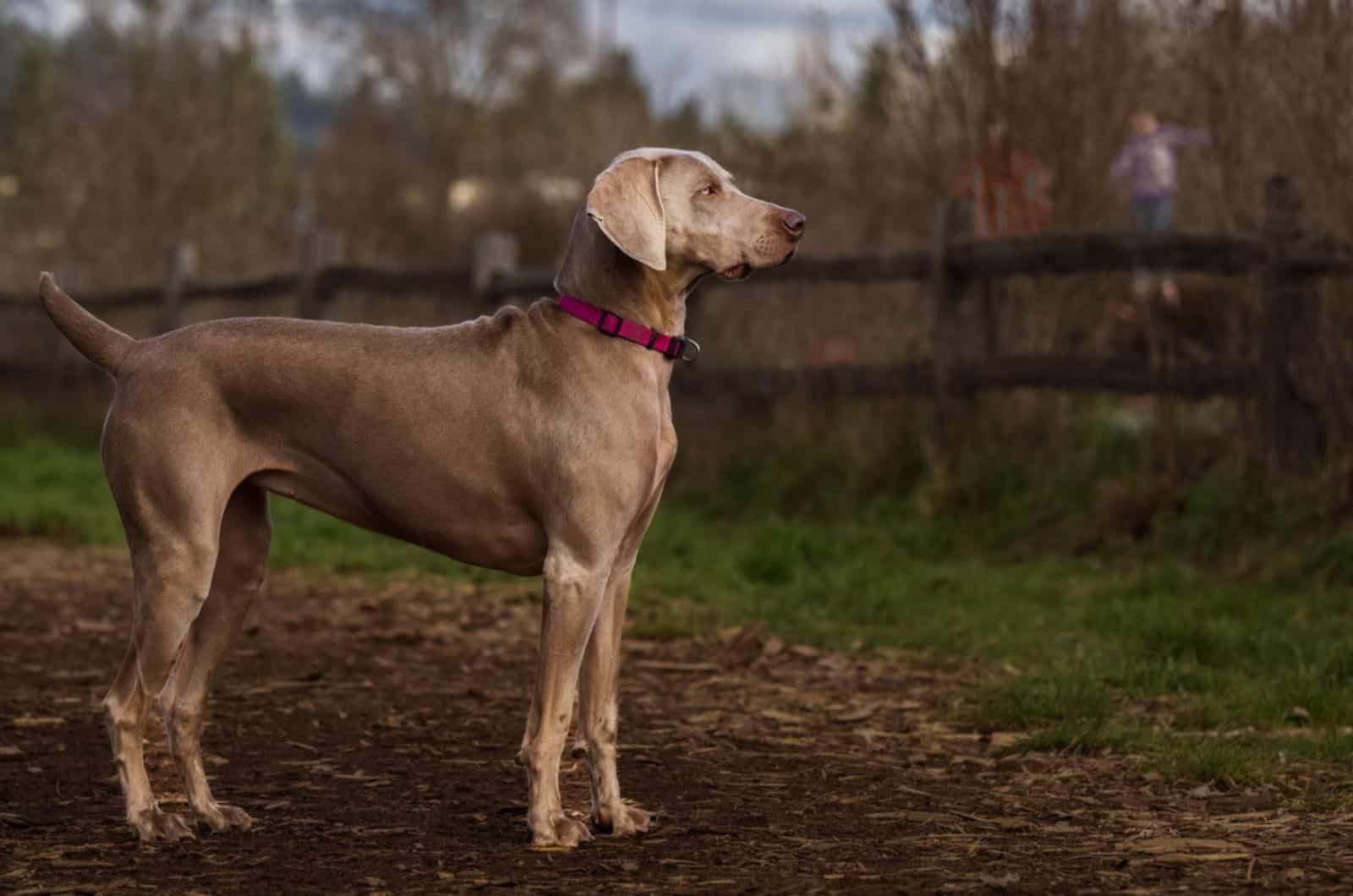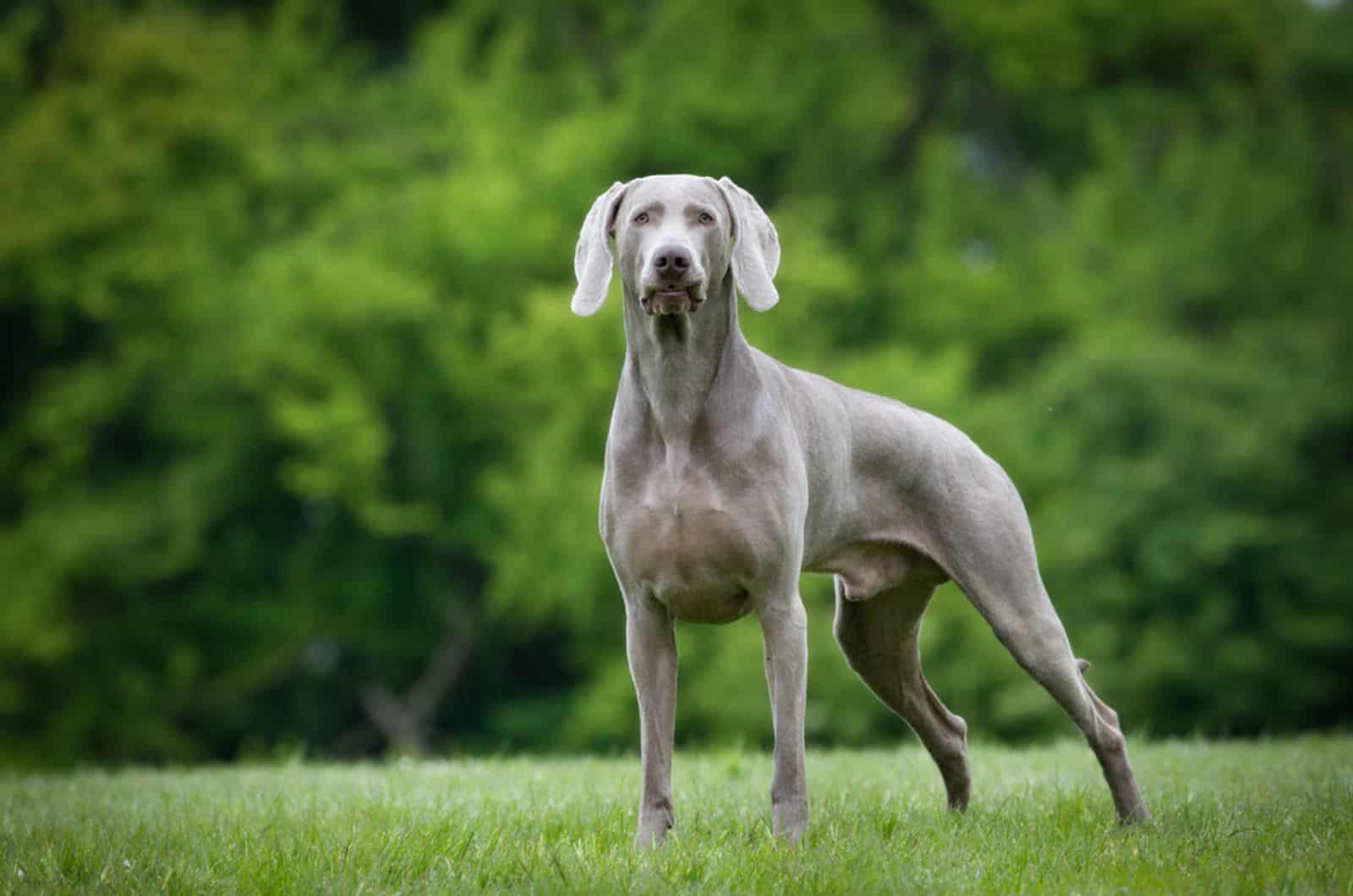Are you a proud Weimaraner owner? I bet you have been wondering about how the Weimaraner growth chart should look. This is an excellent chance to revise your puppy’s growth, and detect how your puppy rates on the growth scale.
Weimaraner puppies, being a large breed, are 70 to 90 pounds heavy, and they reach up to 27 inches in height. However, their growth from early age to adulthood has a long and complex path.
These canines make excellent human companions. This especially goes for sportsmen and people with a very active lifestyle. However, in order to make your Weimaraner even more compatible, you need to take care of your puppy’s needs throughout its different life stages.
The question is: ‘‘How exactly do they grow?’’ Take a look at this growth chart and find out everything about your Weimaraner puppy’s development!
The Weimaraner Growth Chart

In order to determine the Weimaraner Growth Chart, we will need to see what the average weight and height of this puppy is. The puppy weight will be explained throughout the weight chart.
The healthy weight of a Weimaraner canine in adult age goes between 70 and 90 pounds. However, this dog breed can go up or down a few pounds, give or take. This isn’t a cause for alarm, but you surely need to consult your vet if your puppy is highly overweight or underweight.
Let’s jump into the weight chart and see the gradual growth of a Weimaraner puppy!
The Weimaraner weight chart by age
[table id=647 /]
From this chart, we can see that the Weimaraner puppy is a large dog breed whose rate of growth moves forward rapidly after the second month. The Weimaraner weight chart needs to be monitored properly, especially during the first couple of weeks.
This is the period when puppies are extremely sensitive and require human assistance. However, if you are willing to buy the puppy, you will probably pick it up after week eight.
The Weimaraner’s cost is based on the quality of the breeder. Make sure you always do research on breeders before you decide to purchase the Weimaraner dog.
When it comes to height, Weimaraners are quite a tall dog breed. They reach up to 27 inches in height. Their long legs and athletic body enable them to hunt and run very fast.
Let’s now take a look at the height chart of Weimaraner puppies!
The Weimaraner height chart by age
[table id=648 /]
The Weimaraner height chart goes up rapidly after week 4. The important thing is to monitor the neonatal stage of your puppy. This is the most fragile period of a Weimaraner’s growth, and it requires deep commitment and supervision.
Both female and male dogs need proper nutrition, a lot of physical activity, and regular vet examinations in order to reach their developmental milestones. We will now try to identify key developmental features of your Weimaraner throughout different life stages. Stay tuned!
A Weimaraner Throughout Puppy Growth Stages

There are three basic life stages of every puppy: puppyhood, the juvenile phase, and adulthood. However, the in-between life stages are just as important as those three. We call them transitional life stages as your puppy is transitioning from one basic phase to another.
For instance, the period between early puppyhood and the juvenile phase is probably one of the most important periods in a Weimaraner’s life. This is because late puppyhood is the time when your canine is perfecting its socialization and obedience skills.
Also, Weimaraners are not the easiest dogs to potty train. Early potty training is key if you want this dog to become a house pet. Weimaraners, just like Shorthaired Pointers, are highly intelligent puppies, but many breeders see this trait as a two-sided coin.
Their intelligence positively correlates with the fact that they are stubborn as well. Weimaraner puppies need creative socialization and obedience training as they are known for outsmarting their owner easily.
On the other hand, well-trained Weimaraner puppies are perfect watchdogs, service dogs and working dogs. They are task-oriented, and they love pleasing their owner.
1. Meeting The World
The most important thing in this early stage of life is that the puppy’s parents are close to the puppy. This especially refers to the puppy’s mother as they need mother’s milk in order to develop properly.
During the early puppyhood stage, puppies have a sense of touch, but they are still unable to see anything.
A warm and nurturing home is what they need during the first several weeks of life. There is a pretty good chance that you will pick up your Weimaraner after the first eight weeks of its life, which means you need to find a quality Weimaraner breeder.
Reputable breeders will make sure your puppy is properly nurtured during puppyhood. This is the time when they receive their first shots and deworming. Health tests are mandatory as these puppies are prone to hip dysplasia, spinal dysraphism, and gastric torsion.
Weimaraner genetics has to be tested, and the puppy has to undergo regular vet visits. Hereditary diseases can be detected during the first couple of weeks, which means that no reputable breeder will sell you an unhealthy puppy.
Dog’s weight is a sensitive topic during the puppyhood stage. You need to make sure the puppy sucks milk properly and doesn’t get stranded by other litter mates. Some Weimaraner puppies will need additional food supplements.
2. Who’s Ready To Play?

Have you just purchased a Weimaraner puppy at the age of eight weeks from a breeder? Well, this is the perfect time to start implementing socialization techniques in your puppy. Their bone density is still underdeveloped, but they are old enough to start playing.
The Weimaraner breed is probably among the most active dogs in the world. They require long hours of exercise, preferably outdoors. Make sure you have a fenced yard as these puppies are fast, even in puppyhood.
Dog training collars are a good option if you’re willing to train your dog. They will help you go through the obedience training easier.
Weimaraners enjoy human company, but they sometimes can be on alert around unknown people. Socialization training is key for successful and healthy growth. Dog food and dog snacks can be used as positive reinforcement.
This is a dog that loves food! Even though they eat much more than small breeds, they have a low tendency of becoming overweight. This is because they are prone to high-level activities.
Another thing that is crucial for the proper development of your puppy in this stage is proper and timely feeding. Healthy weight gain will help your puppy develop a strong, muscular body physique, which is what Weimaraners are known for.
This large breed will have a slightly bigger protein intake with respect to other dog breeds as protein boosts their energy level and helps them build muscles.
3. Weimaraner Puppy – A Half Grown Puppy
The juvenile phase starts at the age of six months. Even though the puppies are 50 to 60 pounds in weight, and 21 to 23 inches in height, they are still half-way through adulthood.
The best time to spay or neuter your canine is during this stage of life. After the sixth month, puppies enter the age of sexual maturity and start acting slightly more unpredictable.
If you’re wondering why your dog is acting weird all of a sudden, one of the answers lies in the fact that they are sexually mature and they want to mate!
To avoid these unpleasant situations, make sure your puppy is spayed or neutered on time. There are numerous benefits of spaying, such as developing a gentler and calmer nature. Also, the puppy’s health is in positive correlation with spaying/neutering.
During this phase, puppies still haven’t reached adult weight. They are almost there, but they still need a lot of mental stimulation and mental development. Female Weimaraner puppies tend to develop faster, though.
The first year in the Weimaraner growth chart is probably the most sensitive. Puppies go through the adaptation process, as well as through obedience and socialization training. Just like Retrievers and Cocker Spaniel, this breed shows exquisite intelligence, and it requires creative ways of entertainment.
Make sure you implement proper socialization techniques as they affect the overall health of your puppy.
4. Here Comes The Adulthood

Weimaraners are considered as adult dogs once they surpass eighteen months of age. Their size reaches up to 90 pounds. Is your puppy weighing more than that? Well, that represents a problem as Weimaraner puppies shouldn’t exceed their recommended weight.
Obese puppies develop bone injuries during exercise as their overall body structure cannot withstand extra weight.
This is an active dog breed that uses its natural agility in hunting. Additionally, obese puppies develop major health problems, such as diabetes and cardiac diseases.
During the adulthood phase, your puppy is going to show more of a calm nature. This refers to their indoor time as they love spending some quiet time with their owner. However, they still need a lot of outdoor exercise in order to maintain their energy on a normal level.
Puppies that don’t receive the proper amount of exercise can be destructive and aggressive, even towards family members.
Generally, Weimaraners do not qualify among aggressive dog breeds. However, you need to make sure your pet receives sufficient amounts of exercise, as well as socialization.
The overall size of a Weimaraner depends on a number of factors. Individual dog needs are something you need to monitor and detect based on personal experience. Quality food is always the best option, as well as regular vet checkups.
Adult Weimaraners can be excellent show dogs as they learn new tricks easily, and they love being engaged in various activities. Agility contests are the Weimaraner’s specialty.
5. Two-Year-Old Weimaraner Puppies: Now What?
Generally, the first two years of your puppy’s life are a breaking point. This is the period when puppies gain basic social skills, and they learn how to behave around people and other pets.
Also, the puppy’s growth in this age goes up rapidly. This especially refers to weight gain as they keep growing until their 18th month of age.
However, the important part is to maintain the ideal weight of your puppy after the first two years of its life.
This athletic breed needs a lot of activity throughout its whole life, and the only way to keep them active is if you maintain their weight within the normal weight ratio.
The Weimaraner’s height is another important determinant in the overall Weimaraner growth chart. Even though this is not the tallest dog breed in the world, these canines reach up to 27 inches, which is pretty fascinating.
The Weimaraner growth chart doesn’t end once puppies enter adulthood. It needs constant monitoring, especially because of the fact that puppies tend to gain more weight in the latter stages of life.
Senior Weimaraners need to be subjected to regular vet examinations as they are prone to heart problems and their life expectancy could be affected. This dog breed is recommended only for people who have enough time in their daily schedule.
If you are a busy person and cannot comply with a Weimaraner’s daily needs, don’t get one. These canines need a companion throughout their whole life, and this means you need to adapt your daily schedule to your puppy.
The Weimaraner Growth Chart Determinants

Even though the Weimaraner growth chart is pretty much based on the puppy’s genetics, there are some factors that affect their overall growth. Four most important determinants of the growth chart are dieting, dog training, health issues, and socialization.
Each of these determinants is equally important for the proper development of your Weimaraner puppy. Also, all determinants are human-based, which means you can affect your puppy’s growth both positively and negatively.
Puppies need proper maintenance, which includes regular grooming, health exams, well-organized feeding charts, and daily exercise. If you’re planning to keep your Weimaraner puppy indoors, make sure that you keep its coat clean.
Even though the puppy has a short, smooth coat type, it still does not qualify among dogs that don’t smell. However, regular baths and using proper dog shampoos will keep your puppy clean at all times.
Now, let’s take a look at each of these four determinants individually and see what the do’s and don’ts are in your Weimaraner growth chart.
1. Dieting

Dieting is closely related to your puppy’s training as these canines’ appetite depends on how hard they exercise. Also, puppies that eat more generally need more exercise in order to burn off calories.
Generally, Weimaraner dogs need at least twenty to thirty percent of protein-based food in their daily feeding chart. This is a lot more than the smallest dog breeds need in a day, but it’s not a surprise. This is a large breed that has an active lifestyle.
Dieting needs to be based on food with healthy macronutrients. Avoid junk food and your leftovers as these canines can suffer from gastric torsion. Also, bloat in these dogs is not an uncommon phenomenon.
Proper dieting is crucial for maintaining energy on a high level. These canines are engaged in numerous outdoor activities, among which, hunting is the most popular. They need quality food in order to remain healthy and active.
Improper dieting can affect your puppy’s overall growth chart. Severe weight loss could probably have deadly repercussions, which is something you don’t want to cause. If, however, your puppy becomes underweight despite the fact that it receives proper amounts of food, you should visit a vet immediately.
Learn more about this dog’s nutritional needs in our Weimaraner feeding chart.2. Dog Training
A Weimaraner’s training may differ structurally from, let’s say, Belgian Malinois training, but these puppies are still high-energy and they perform excellently. Weimaraner puppies show outstanding physical abilities, and their athletic body makes them one of the most agile dogs in the world.
This hunting dog learns new tricks easily. Due to their exquisite intelligence, they are favorable for dog competitions and dog shows.
Exercising helps the Weimaraner dog breed develop properly as this is a muscular dog by default, and it requires a lot of activity during the day in order to remain healthy.
The Weimaraner growth chart is highly impacted by exercise as inactive dogs develop poorly, and they could suffer from various diseases. Bone density is emphasized in active Weimaraner dogs more than in those puppies that have a lazy daily routine.
This is generally not the breed for first-time dog owners as Weimaraner dogs require strong leadership. In order to be the pack leader, you need to have a firm, solid attitude as these canines show stubbornness at times.
Properly exercised Weimaraners have an excellent appetite, and at the end of the day, you will be asking yourself, Is there ever enough food for these magnificent canines? They are passionate eaters.
However, there is a thin line between proper feeding and excessive feeding in the Weimaraner breed. Make sure you don’t cross it.
3. Health Issues

These canines are not the healthiest dog breed in the world as they face some hereditary diseases. The most common health issues in Weimaraner dogs are hip dysplasia, spinal dysraphism, Gastric Dilatation Volvulus, and gastric torsion.
Reputable breeders will subject the puppy to regular DNA testing, as well as to regular veterinarian exams. You need to maintain this practice if you want to keep the Weimaraner growth chart on track.
Puppies that suffer from hip dysplasia or other structural problems will probably develop slowly, and they won’t be able to perform as healthy dogs.
Resolving these problems should be the top priority for a Weimaraner owner as inactive dogs are unhappy, and they often come across as destructive. Due to their high intelligence, Weimaraner puppies can suffer from severe anxiety, too.
The puppy’s health is in a direct relationship with the growth chart. This is something you need to bear in mind at all times. Even suffering from some minor health condition, such as ear infections or skin problems can cause great trauma in your puppy.
Untreated health problems are bad news in the long run, and they won’t have a favorable outcome.
4. Socialization
You are probably wondering what socialization has to do with the Weimaraner growth chart. Well, it does play a huge role in the overall growth of your puppy. You should take into consideration that the puppy’s growth doesn’t only imply its physical development.
Mental development is also a key in the Weimaraner growth chart development. This intelligent dog needs to be mentally challenged on a daily basis, and the best way to do this is to implement positive reinforcement.
This way, you develop its social skills and mental stability at the same time. Unsocialized Weimaraner canines come across as stubborn and disobedient. It is not rare that they even show aggression towards unknown people.
Early socialization is required as it helps your puppy live a happy, anger-free life. Also, ‘‘How to socialize an aggressive dog?’’ won’t be an issue!
There is a direct link between socialized puppies and their proper growth. How? Well, socialized canines have a stable daily routine and a positive attitude. This directly impacts their serotonin levels. Furthermore, a decreased stress level adds to their overall well-being, and makes them prone to healthy habits.
When Do Weimaraners Stop Growing?

The answer to this question depends on the individual dog. Both male and female Weimaraner dogs have their own individual growth pattern. However, there are some growth patterns that apply to all dogs, and they help us realize where our puppies stand currently.
Usually, these canines stop growing by the end of the eighteenth month. However, there are a number of Weimaraner dogs that stop growing much earlier.
We can see from the height chart in the previous part of this article that many Weimaraner puppies almost reach their full size between their eight and tenth month of age.
However, fully-grown puppies are not necessarily mentally mature dogs. Even though they reach their maximum in body weight and height, they still have a long way to go in order to develop mentally.
The best thing is to stick with the Weimaraner growth chart and to let your puppy develop gradually. Any deviation in feeding habits will have a negative effect on your puppy’s overall growth.
FAQs
1. How Old Do Weimaraners Live?
The Weimaraner breed is not the healthiest dog breed in the world. However, these canines easily reach up to 13 years in age. This is due to their healthy lifestyle and high-level activities.
Even though they are not as healthy as Poodles or Labradors, they are still favorable for crossbreeding. You can find amazing Weimaraner mixes all over the United States and beyond.
Weimaraner puppies qualify among large dogs whose lifespan revolves around 9, to 12 or 13 years. With proper feeding, regular daily exercise, and timely vet visits, your dog can live a long and happy life.
2. How Big Will My Weimaraner Be?
A good part of your Weimaraner growth chart depends on genetics. However, there are things that impact the overall growth of your puppy, such as feeding habits, training routine, socialization, and health issues.
Usually, healthy canines are between 70 and 90 pounds in weight. Other than that, they reach up to 27 inches in height. As long as your canine is within these proportions, it is considered healthy.
However, their weight can either go up or down by a few pounds. A slight change in their weight chart doesn’t have to be alarming. Still, if you notice that your Weimaraner puppy is drastically overweight or underweight, you should seek help from your veterinarian.
Additionally, any abnormality, such as an unusual dog’s tongue color, or a strange behavior needs to be checked by a vet.
3. At What Age Is A Weimaraner Fully Grown?
Generally, all puppies reach adulthood at 18 months of age. Some experts consider a puppy to be fully grown at two years.
However, there are Weimaraner puppies that reach their full size before they enter adulthood.
This is relative, and it depends on your dog exclusively. If, however, you notice that your dog is still highly underdeveloped at 18 months of age, you should immediately go to the vet and see if there are any major health concerns.
If you’re wondering how heavy your dog should be, you should research the Weimaraner growth chart more closely.
Conclusion
The Weimaraner growth chart is an important topic that needs careful consideration. It helps you detect your puppy’s regular development, and prevents potential overeating.
Generally, these canines don’t have a problem with obesity as they are active, playful, and have a high level of energy.
Weimaraner puppies are healthy dogs that develop properly. However, there are some things, such as health issues or improper establishment of their feeding chart that could impact their growth chart.
Related content: Mini Weimaraner: Shrunken Down To Cuteness
